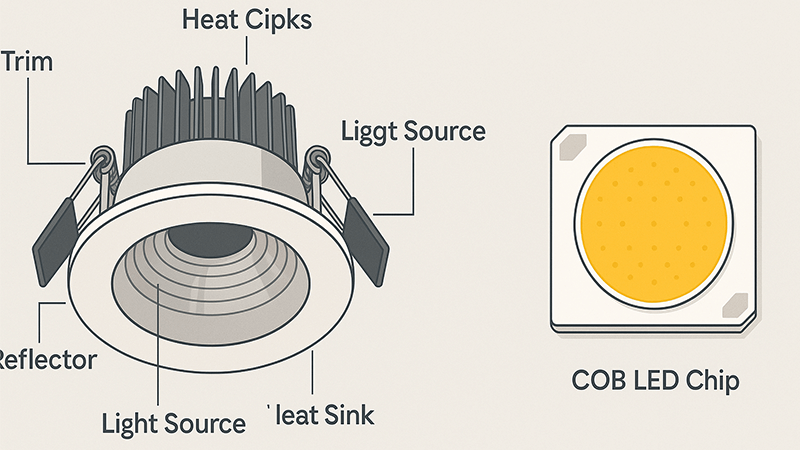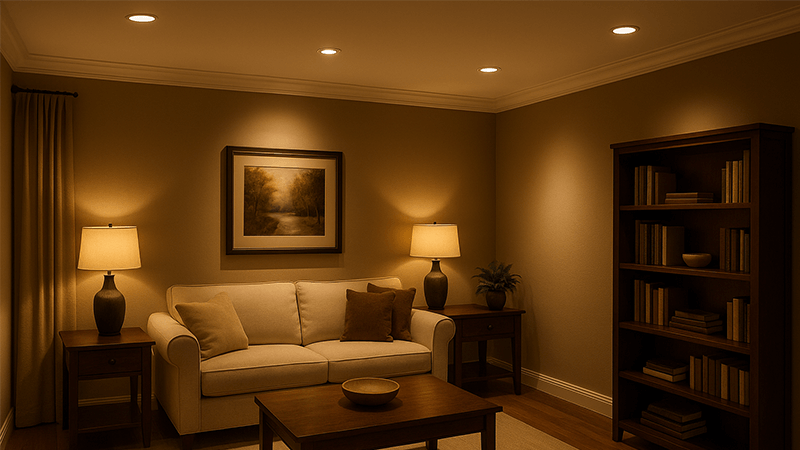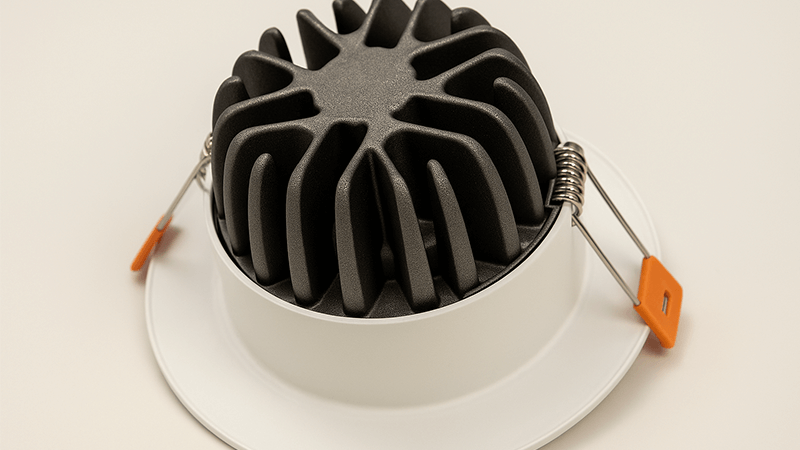Choosing the right lighting feels complicated. Making the wrong choice can ruin a room’s feel. Let’s clarify this common question so you can select the perfect lighting solution.
A downlight is a type of fixture, while COB (Chip on Board) is a type of LED light source. The question isn’t which is better, but how to best combine fixture types and light sources. For most projects, standard LED downlights for general light and COB spotlights for accent light is the ideal combination.

This question is one I hear all the time from purchasing managers and designers. It comes from a simple mix-up between a light fixture’s form and the technology inside it. In my early days in the factory, I saw this confusion lead to so many ordering mistakes. A client would ask for "COB lights" when they really needed general-purpose downlights. Or they’d order "downlights" and be disappointed by the wide, soft beam when they needed to highlight a feature wall. Understanding the real difference isn’t just technical—it’s the key to unlocking a truly great lighting plan. Let me walk you through exactly how I explain this to my partners, so you can specify your projects with total confidence.
What is the difference between a COB light and a downlight?
Technical lighting terms can be confusing. This confusion often leads to expensive purchasing mistakes and project delays. Let’s break down the simple difference so you can order correctly every time.
A downlight is a recessed light fixture that shines light downwards into a space. COB, or Chip on Board, is a light source technology. A downlight fixture can use a COB chip as its light source, but they are not the same thing. Think of it like a car and its engine.

When I first started helping clients like Shaz in the UAE source lighting, this was the number one point of confusion. He was working on a large residential tower and his bill of quantities listed "COB lights" for the entire apartment. The project needed both soft, ambient light for living areas and focused light for kitchens and hallways. If he had ordered only COB spotlights, the living rooms would have felt like a museum, with harsh spots of light instead of a comfortable, even glow.
I explained that we needed to think in two steps. First, the fixture type. Second, the light source technology.
The Fixture: The Downlight
A downlight is a luminaire installed into a hollow opening in a ceiling. It directs light downward in a controlled beam. Its main job is to provide general or ambient lighting.
- Fixed Downlights: These have a static beam and are perfect for providing uniform illumination across a large area, like an office or living room.
- Adjustable (Gimbal) Downlights: These can be tilted and swiveled. They are more like spotlights and are great for accent lighting, directing focus onto artwork, architectural details, or workspaces.
The Light Source: COB vs. SMD
The light itself comes from an LED chip. There are two main types used in downlights:
- SMD (Surface Mounted Device): These are tiny, individual LED chips placed across a circuit board. They create a wide, diffuse, and even light, which is why they are perfect for general-purpose downlights.
- COB (Chip on Board): This technology bundles many small LED chips together into a single, dense module. This creates a powerful, high-intensity, and focused beam of light, much like a traditional halogen bulb. This is why COB is the preferred choice for spotlights and accent lighting.
Here is a simple table to show the difference:
| Feature |
SMD (Surface Mounted Device) |
COB (Chip on Board) |
| Appearance |
Multiple small, separate LED chips on a board |
A single, large, uniform-looking light source |
| Light Quality |
Wide, diffuse, even light (less glare) |
Intense, focused, high-density light (can create glare) |
| Best Use Case |
General ambient lighting (standard downlights) |
Accent lighting, high ceilings (spotlights) |
| Heat |
Heat is spread out over many chips |
Heat is concentrated in one small area |
By breaking it down this way for Shaz, he understood he didn’t need to choose between them. He needed SMD downlights for general living spaces and COB spotlights for highlighting kitchen counters and architectural features. The project was a huge success.
Which type of light is best for a home?
Choosing lights for a home feels overwhelming. The wrong choice can make a comfortable space feel harsh or sterile. Let’s create a simple strategy for a perfect lighting layout.
The best approach is not to pick one type of light, but to use a layered lighting strategy. Combine standard SMD LED downlights for general ambient lighting with COB LED spotlights to create accents and highlight features. This combination provides both function and style.

There is no single "best" light for a home. A home has many different rooms, each with different needs. A lighting plan that works for a kitchen will not work for a bedroom. That’s why I always advise my partners to think in layers. A good lighting plan uses three main layers to create a space that is both functional and beautiful. I’ve helped countless distributors and contractors design plans for residential projects using this simple method. It ensures the end-user gets a home that feels exactly right.
Layer 1: Ambient Lighting (The Foundation)
This is the base layer of light that provides overall illumination. It allows you to move around the room safely and comfortably.
- What to use: Standard LED downlights with SMD technology are perfect for this.
- Why: They provide a wide, soft, and even light that fills the space without creating harsh shadows or glare. They are the workhorses of residential lighting.
- Where to use: Living rooms, bedrooms, hallways, and open-plan areas. The goal is to create a consistent, comfortable foundation of light.
Layer 2: Task Lighting (The Focus)
This is focused light for specific activities like reading, cooking, or working.
- What to use: This can be a COB downlight (spotlight), an under-cabinet light, a desk lamp, or a vanity light.
- Why: COB spotlights deliver a strong, directed beam of light exactly where it’s needed, making tasks easier and reducing eye strain. For example, over a kitchen island or a home office desk.
- Where to use: Kitchen countertops, reading nooks, home offices, and bathroom vanities.
Layer 3: Accent Lighting (The Drama)
This layer adds depth, interest, and style. It is used to highlight architectural features, artwork, plants, or decorative objects.
- What to use: Adjustable COB spotlights are the best tool for this job.
- Why: Their powerful, narrow beam creates a dramatic focal point. You can aim them precisely to draw the eye to what you want to showcase. This is what makes a room feel professionally designed.
- Where to use: Pointed at a textured wall, a piece of art, a fireplace, or indoor plants.
Here is how you might combine these lights in a typical living room:
| Lighting Layer |
Fixture Type |
Light Source |
Purpose in Living Room |
| Ambient |
Fixed Downlight |
SMD LED |
Provides general, even illumination for the whole room. |
| Task |
Floor Lamp |
Varies |
Placed next to a sofa for comfortable reading. |
| Accent |
Adjustable Downlight |
COB LED |
Highlights a piece of artwork on the wall, creating a focal point. |
By using this layered approach, you are not choosing one light over another. You are using the right light for the right job, creating a lighting design that is complete, functional, and beautiful.
What is the lifespan of a COB light?
You worry that new lighting technology won’t last. Installing lights that fail early leads to unhappy customers and costly replacements. Let me explain the real factors affecting COB light lifespan.
A high-quality COB LED light can last between 30,000 to 50,000 hours. However, its actual lifespan depends heavily on the quality of the heat sink, the driver, and the operating environment. A great chip with poor thermal management will fail quickly.

I’ve seen it happen many times. A contractor buys a cheap COB spotlight based on a fantastic advertised lifespan. A year later, I get a call. The lights are flickering, or half of them have failed completely. The problem is almost never the COB chip itself. The issue is everything built around it. At iPHD, we learned early on that the chip is just one part of the equation. To deliver on our promise of "Lighting Quality You Can See," we had to become experts in thermal management and driver technology. Lifespan is not just a number on a box; it’s a result of quality engineering.
Factor 1: The Heat Sink (Thermal Management)
This is the most critical factor for COB lifespan. COB technology packs many LED chips into a very small area, which generates a lot of concentrated heat.
- Why it matters: If this heat isn’t drawn away efficiently, the chip’s temperature will rise. High temperatures cause the lumen output to decrease permanently (lumen depreciation) and can lead to complete failure.
- What to look for: A well-designed heat sink, usually made of die-cast or cold-forged aluminum. It should have a large surface area (many fins) to dissipate heat into the air effectively. A cheap, small, or poorly designed heat sink is the number one cause of premature COB light failure.
Factor 2: The LED Driver
The driver is the power supply for the LED. It converts AC power from the wall into the low-voltage DC power the COB chip needs.
- Why it matters: A low-quality driver can provide unstable current, cause flickering, and fail long before the LED chip does. A common saying in our industry is, "A luminaire is only as reliable as its driver."
- What to look for: Look for lights that use drivers from reputable brands (like Philips, Osram, Tridonic, or Lifud). A good driver ensures a stable power supply and includes protection against overheating and power surges, significantly extending the life of the entire fixture.
Factor 3: The Operating Environment
Where and how the light is used also plays a big role.
- Temperature: Installing a COB downlight in a very hot ceiling void without proper ventilation will shorten its life. Always check the manufacturer’s recommended operating temperature.
- Usage: The 50,000-hour rating is based on an average usage pattern (e.g., 8 hours a day). A light used 24/7 will reach the end of its rated life much sooner in terms of years, even though it achieves its total hour rating.
Here is a summary of what determines real-world lifespan:
| Component Quality |
Impact on Lifespan |
What We Focus On at iPHD |
| Heat Sink |
High Impact. Poor heat management is the main cause of failure. |
We use cold-forged aluminum for maximum thermal conductivity and design fins for optimal airflow. |
| LED Driver |
High Impact. Unstable power or driver failure will kill the light. |
We partner with leading driver brands and ensure our drivers match the LED chip’s requirements perfectly. |
| COB Chip |
Medium Impact. Most chips from reputable brands are reliable. |
We source chips from top manufacturers like Cree, Citizen, and Bridgelux for high efficacy and consistency. |
So, when you see a 50,000-hour lifespan, ask about the heat sink and the driver. That is how you identify a truly high-quality COB light that will last.
What is the healthiest lighting?
You want to create spaces that are not just bright, but also healthy. Poor lighting can cause eye strain, headaches, and disrupt sleep. Let’s define what makes lighting healthy.
The healthiest lighting is human-centric lighting. It minimizes flicker, has a high Color Rendering Index (CRI >90), offers tunable white options to match natural daylight cycles, and is designed to reduce glare. It prioritizes visual comfort and supports our natural circadian rhythm.

When I started my company, the focus was all on lumens per watt—efficiency. But over the years, I’ve worked with architects and designers on schools, hospitals, and offices where the well-being of the people inside was the top priority. This taught me that the quality of light is far more important than the quantity. "Healthy lighting" isn’t a specific product. It’s a design philosophy that puts human biology first. We spend so much of our lives indoors, so the artificial light we use must support our health, not harm it. This has become a core part of our mission at iPHD.
CRI measures how accurately a light source shows the true colors of objects. The sun has a CRI of 100.
- Why it’s healthy: Low CRI light makes colors look dull and washed out, which can cause eye strain as our brains work harder to interpret what we see. High CRI light (CRI >90) makes environments look more natural and vibrant, improving visual comfort and even our mood. For detail-oriented tasks, it’s essential.
Pillar 2: Low Flicker
Flicker is the rapid, often invisible, fluctuation in a light’s brightness. It’s usually caused by a low-quality LED driver.
- Why it’s healthy: Even if you can’t see it, your brain can detect flicker. It can lead to headaches, eye fatigue, and reduced concentration. Truly healthy lighting should be flicker-free, which requires a high-quality driver.
Pillar 3: Tunable White & Circadian Rhythm
Our bodies are programmed to follow the 24-hour cycle of natural light—our circadian rhythm. This cycle affects our sleep, alertness, and overall health.
- Why it’s healthy: Tunable white lighting can change its color temperature throughout the day to mimic sunlight.
- Morning/Day: Cool white light (4000K-5000K) promotes alertness and concentration.
- Evening: Warm white light (2700K-3000K) helps our bodies relax and prepare for sleep.
- Matching indoor lighting to this natural rhythm is one of the biggest advancements in healthy lighting.
Pillar 4: Glare Control
Glare is the visual discomfort caused by excessive or uncontrolled brightness.
- Why it’s healthy: Direct glare from a light source can make it difficult to see and cause significant eye strain. Healthy lighting uses fixtures designed to control the light output. For downlights, this means using deep-set LED sources, anti-glare reflectors, or honeycomb louvers to shield the light source from direct view.
Here’s a checklist for specifying healthy lighting:
| Healthy Lighting Feature |
Technical Specification |
Benefit for Occupants |
| High Color Accuracy |
CRI > 90, R9 > 50 |
Reduces eye strain, improves mood, true color appearance. |
| No Flicker |
Use high-quality, flicker-free drivers |
Prevents headaches, eye fatigue, and concentration issues. |
| Circadian Support |
Tunable White (e.g., 2700K to 5000K) |
Boosts daytime alertness and supports natural sleep cycles. |
| Glare Control |
UGR (Unified Glare Rating) < 19 |
Maximizes visual comfort and prevents eye strain. |
The healthiest lighting is a complete system. It’s not about choosing a COB or an SMD. It’s about choosing a high-quality fixture with high CRI, no flicker, and good glare control, then using it in a way that supports the occupants’ well-being.
Conclusion
The debate isn’t downlight versus COB. It’s about using SMD downlights for ambient light and COB spotlights for accents. Understanding this difference is key to creating truly effective lighting designs.